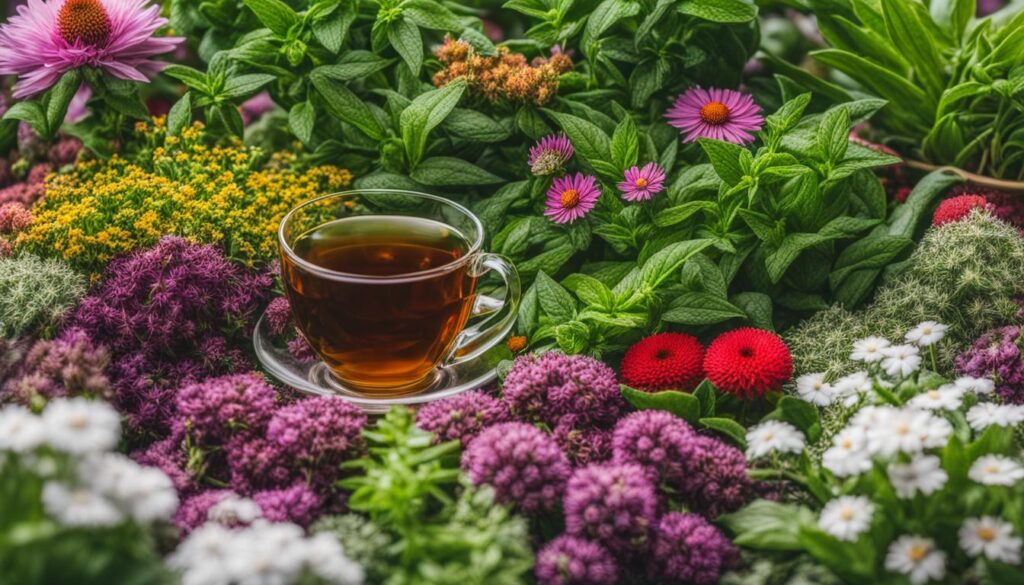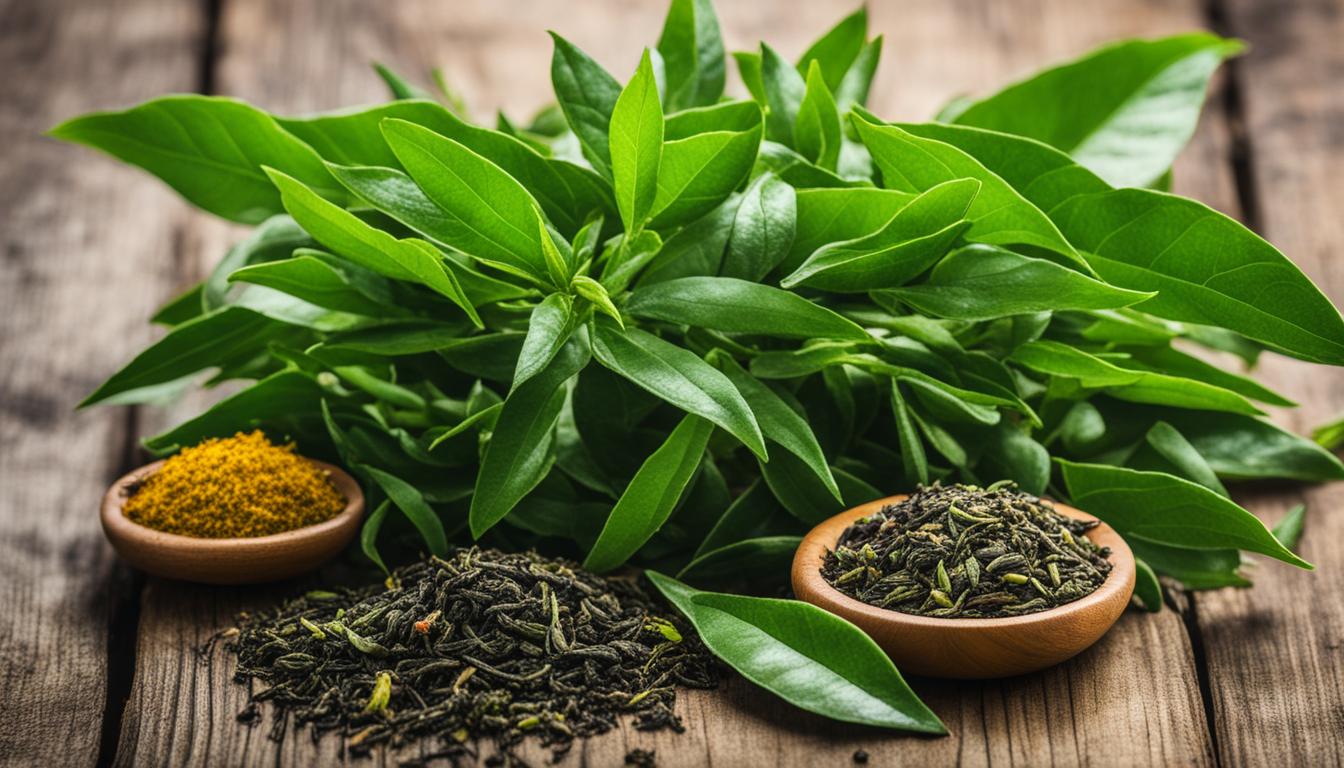Greetings fellow tea enthusiasts! Today, we’re diving into the fascinating world of tea plant disease prevention methods. As avid tea lovers and growers ourselves, we understand the importance of keeping our tea crops healthy and thriving. By implementing proactive measures, we can successfully thwart those pesky diseases and ensure the longevity of our beloved tea plants.
Tea plant disease prevention is not only crucial for the health and productivity of our tea crops, but it also plays a significant role in maintaining the high quality and exquisite taste of our teas. Imagine sipping on a cup of tea that has been nurtured from disease-free plants – pure bliss!
So, grab your favorite tea mug and let’s explore the proactive methods that can help us protect our precious tea plants from diseases.
Key Takeaways:
- Implement early detection, disease-resistant varieties, and integrated disease management to effectively prevent and manage tea plant diseases.
- Understanding the causes and symptoms of tea plant diseases is essential for effective prevention and control.
- Proactive measures, such as natural remedies, early detection, and disease management protocols, can significantly reduce the risk of tea plant diseases.
- Planting disease-resistant tea plant varieties and regular health monitoring are important strategies for preventing diseases.
- Integrated disease management combines multiple strategies, including cultural practices and good tea garden sanitation, to control diseases in tea cultivation.
Understanding Tea Plant Diseases and their Causes
Tea plants are highly susceptible to a variety of diseases caused by fungi, bacteria, and other pathogens. These diseases can have a significant impact on the health and productivity of tea crops. To effectively prevent and control these diseases, it is vital to understand their causes and symptoms.
Fungal diseases pose a considerable threat to tea plants, especially in moist conditions. Common fungal diseases in tea plants include blight and mildew, which can result in leaf discoloration, wilting, and reduced yield. By implementing proactive measures, such as proper irrigation and ventilation, growers can prevent the development and spread of fungal diseases in their tea gardens.
Similarly, bacterial diseases, such as bacterial leaf spot, can affect tea plants and cause symptoms like leaf spots, lesions, and wilting. Preventing bacterial diseases requires careful sanitation practices such as removing and disposing of infected plant material and implementing crop rotation strategies to minimize disease buildup.
“Preventing fungal diseases in tea plants and effectively controlling bacterial diseases are essential aspects of tea plant disease management.”
Fungal Diseases in Tea Plants
Fungal diseases in tea plants can be categorized into multiple types, including leaf blight, powdery mildew, and root rot. Each type of fungal disease has distinct causes and symptoms, requiring different management strategies.
| Fungal Disease | Causes | Symptoms |
|---|---|---|
| Leaf Blight | Caused by the fungus Colletotrichum camelliae. | Leaves develop dark, water-soaked lesions that make the plant vulnerable to other diseases. |
| Powdery Mildew | Caused by the fungi Oidium theae and Erysiphe sp. | White or grayish powdery patches appear on the leaves, leading to leaf distortion and reduced photosynthesis. |
| Root Rot | Caused by the fungi Fusarium solani and Phytophthora spp. | Roots become dark and soft, leading to wilting and eventual plant death. |
Understanding the specific causes and symptoms of fungal diseases is crucial for effective prevention and control. By implementing targeted management strategies and practicing good garden hygiene, tea growers can minimize the risk of fungal diseases and ensure the long-term health and productivity of their tea crops.
Proactive Measures for Tea Plant Disease Prevention
When it comes to tea plant disease prevention, taking proactive measures is key to ensuring the health and productivity of your tea crops. By implementing these measures, you can significantly reduce the risk of diseases in your tea garden and promote the long-term sustainability of your plants.
Early Detection and Regular Monitoring
One of the most important steps in tea plant disease prevention is early detection. Regularly monitoring your tea plants allows you to identify any signs of disease at an early stage, enabling timely intervention to prevent further spread.
Make it a habit to inspect your plants regularly, looking for symptoms such as leaf discoloration, wilting, or unusual growth patterns. Pay close attention to areas where diseases are more likely to thrive, such as damp areas or spots with poor air circulation.
Tip: Keep a record of your observations to track any patterns or changes over time. This can help you identify potential disease risks and take appropriate action.
| Disease | Symptoms | Preventive Measures |
|---|---|---|
| Fungal Diseases | Leaf discoloration, wilting, reduced yield | Regular pruning to improve air circulation, proper irrigation management to avoid excessive moisture, and the use of organic fungicides. |
| Bacterial Diseases | Leaf spots, lesions, wilting | Sanitation practices, such as removing and disposing of infected plant materials, crop rotation, and the use of disease-resistant tea plant varieties. |
Tea Garden Disease Management Protocols
Having well-defined disease management protocols in your tea garden can play a crucial role in preventing diseases and minimizing their impact. These protocols should include a set of practices that promote plant health and prevent disease buildup and spread.
Some key components of tea garden disease management protocols include:
- Sanitation: Regularly remove and dispose of any infected plant materials to prevent the spread of diseases.
- Crop Rotation: Rotate your tea crops to different areas of your garden to reduce the risk of disease recurrence.
- Proper Spacing: Ensure adequate spacing between tea plants to allow for good air circulation and minimize the spread of diseases.
Quote: “Implementing disease management protocols is like creating a shield for your tea plants, protecting them from the threats of diseases.” – TeaGrower123

By incorporating these proactive measures into your tea plant disease prevention strategy, you can take control of your tea garden’s health and ensure the longevity of your crops. Remember, prevention is always better than cure, and it’s never too early to start implementing these measures.
With early detection, regular monitoring, and the implementation of tea garden disease management protocols, you can keep your tea plants healthy and thriving, providing you with a bountiful harvest of flavorful tea for years to come.
Disease-Resistant Tea Plant Varieties
Planting disease-resistant tea plant varieties is an effective strategy for preventing diseases and ensuring the long-term health and productivity of tea gardens. These varieties have been bred to possess natural resistance or tolerance to specific pathogens, making them less susceptible to disease. By incorporating disease-resistant tea plants into their cultivation practices, growers can minimize the risk of disease outbreaks and reduce the need for chemical treatments.
Tea plant health monitoring plays a crucial role in the successful implementation of disease-resistant varieties. Regular monitoring allows growers to identify any early signs of disease and take appropriate action to prevent further spread. Monitoring can involve visual inspection of the plants, checking for symptoms such as leaf spots, discoloration, or wilting. Additionally, molecular techniques can be used to detect specific pathogens in the plants, providing a more accurate assessment of their health status.
When selecting disease-resistant tea plant varieties, it is important to consider the specific diseases prevalent in the region and choose varieties that offer resistance to those particular pathogens. For example, if fungal diseases like blight and mildew are common, selecting tea plant varieties with natural resistance to these fungi can help prevent disease outbreaks and maintain tea crop health. Additionally, tea plant breeders are continually developing new disease-resistant varieties through targeted breeding programs, providing growers with a wider range of options to choose from.
In summary, planting disease-resistant tea plant varieties and implementing regular health monitoring are essential steps in preventing diseases in tea cultivation. By selecting varieties with natural resistance to specific pathogens and closely monitoring plant health, growers can effectively reduce the risk of disease outbreaks and ensure the long-term sustainability of their tea gardens.
Integrated Disease Management in Tea Cultivation
When it comes to tea cultivation, implementing integrated disease management practices is essential for maintaining the health and productivity of tea plants. By combining various strategies and techniques, growers can effectively prevent and control diseases, ensuring the long-term sustainability of their tea gardens.

One crucial aspect of integrated disease management is practicing good tea garden sanitation. This includes removing and properly disposing of diseased plant materials, as they can serve as a source of infection and disease spread. Regularly cleaning and disinfecting tools and equipment used in the garden can also help prevent the transmission of pathogens.
In addition to sanitation practices, cultural practices play a significant role in disease prevention. Proper pruning techniques can improve air circulation and sunlight penetration, reducing the favorable conditions for disease development. Optimal irrigation management and soil nutrient optimization can also promote plant health and enhance disease resistance.
Furthermore, integrated disease management involves the use of biological control agents and natural remedies, such as beneficial insects and organic fungicides. These methods can help suppress disease-causing pathogens and reduce the reliance on chemical-based treatments. Regular monitoring of tea plants for any signs of disease is crucial for early detection and timely intervention.
By implementing integrated disease management practices, tea growers can effectively minimize the risk of diseases and maintain the health and productivity of their tea crops. With a combination of proper sanitation, cultural practices, and biological control methods, tea gardens can thrive and produce high-quality tea while ensuring the long-term sustainability of the industry.
Tea Plant Disease Treatment Options
When tea plants are affected by diseases, it is crucial to have effective treatment options available. The success of treatment depends on the specific disease and its severity, as well as the environmental and health considerations of the tea garden. Here are some common tea plant disease treatment options:
- Organic Treatments: Organic treatments are preferred by many tea growers as they are safe for the environment and can be used in organic tea production. Natural substances such as neem oil, compost tea, and plant extracts can be used to control fungal and bacterial diseases. These treatments work by improving plant resistance and creating an unfavorable environment for pathogens.
- Chemical-Based Treatments: In some cases, chemical-based treatments may be necessary to effectively control and manage tea plant diseases. Chemical fungicides and bactericides can be used under strict guidelines and regulations to prevent the spread of diseases. It is important to ensure that any chemicals used are approved for use on tea plants and do not pose a risk to human health or the environment.
- Integrated Approaches: Integrated disease management combines multiple treatment methods to maximize effectiveness. This approach may include cultural practices, such as pruning infected plant parts, improving soil health, and implementing proper irrigation techniques. Combining organic and chemical treatments with cultural practices can provide a comprehensive approach to disease control.
“The choice of treatment option depends on several factors, including the disease type, severity, and the grower’s preference for organic or chemical treatments. It is important to consult with agricultural experts or extension services to determine the most appropriate treatment for your specific tea plant diseases.”
Implementing treatment options should always be done with caution and with consideration for the long-term health and sustainability of the tea garden. Regular monitoring and early detection of diseases, coupled with prompt and appropriate treatment, can help tea growers effectively manage and control diseases, ensuring the health and productivity of their tea crops.
Table: Common Tea Plant Disease Treatment Options
| Treatment Options | Advantages | Disadvantages |
|---|---|---|
| Organic Treatments | – Safe for the environment – Can be used in organic tea production – Improve plant resistance | – May require more frequent applications – Effectiveness may vary – Limited control for severe infections |
| Chemical-Based Treatments | – Highly effective against specific pathogens – Rapid control of diseases – Wide range of available products | – Potential environmental and health risks – Risk of developing resistance – Strict regulations and guidelines |
| Integrated Approaches | – Comprehensive disease control – Combines various treatment methods – Reduces reliance on single options | – Requires careful planning and coordination – Time-consuming to implement – Effectiveness may vary |
Table: Common Tea Plant Disease Treatment Options
Conclusion
As tea growers, we understand the importance of preventing diseases in our tea plants to ensure the health and productivity of our tea crops. That’s why we implement proactive measures to keep our tea gardens thriving. By using disease-resistant varieties, practicing good garden hygiene, and monitoring the health of our plants, we can effectively prevent and manage tea plant diseases.
Regular monitoring is crucial in detecting any signs of disease at an early stage. This allows us to take prompt action and prevent further spread. Early intervention is key to successful disease prevention and control in tea cultivation. With proper disease management protocols in place, we can ensure the long-term health and sustainability of our tea gardens.
Tea garden disease prevention and tea crop health management are our top priorities. We combine our knowledge of natural remedies, such as chamomile tea and garlic soup, with cultural practices like crop rotation and proper spacing. Integrated disease management is our approach, which includes practices such as pruning, irrigation management, and soil nutrient optimization. We are committed to maintaining good garden sanitation practices by removing and disposing of diseased plant materials to prevent the spread of diseases.
In conclusion, by staying proactive and implementing these measures, we can protect our tea plants from diseases and preserve the quality of our tea crops. With continuous monitoring, early detection, and timely intervention, we ensure that our tea gardens stay healthy and productive for years to come. Let’s keep our tea gardens disease-free and our tea crops thriving!
FAQ
What are the proactive methods for preventing tea plant diseases?
Proactive methods for preventing tea plant diseases include early detection, disease-resistant varieties, and integrated disease management.
What are the common causes of tea plant diseases?
Tea plant diseases can be caused by fungi, bacteria, and other pathogens. Fungal diseases thrive in moist conditions, while bacterial diseases can manifest as leaf spots or wilting.
Are there any natural remedies for controlling tea plant diseases?
Yes, natural remedies such as chamomile tea and garlic soup can have antibacterial and fungicidal properties that help control diseases.
How important is early detection in preventing tea plant diseases?
Early detection is crucial in preventing tea plant diseases as it allows for timely intervention and prevents further spread.
What are disease-resistant tea plant varieties?
Disease-resistant tea plant varieties are bred to possess natural resistance or tolerance to specific pathogens, reducing the risk of disease.
What is integrated disease management in tea cultivation?
Integrated disease management involves combining multiple strategies, such as cultural practices and good garden hygiene, to prevent and control diseases in tea cultivation.
What treatment options are available for tea plant diseases?
Treatment options for tea plant diseases may include organic and chemical-based treatments, depending on the specific disease and severity.





